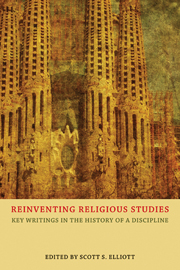Book contents
- Frontmatter
- Contents
- Introduction
- 1 For such a time as this: the Council of Societies for the Study of Religion, 1969–2009
- Part I Inventing and reinventing the field of religious studies
- Part II Method and theory in religious studies
- Part III Teaching religion
- Part IV Women and the bible in religious studies
- Part V Religion and religious studies in civic life
- Part VI Religious studies and identity politics
- Part VII Islam and 9/11
- 37 On the teaching of Islam in America
- 38 Reflections on teaching about September 11
- 39 Death and memory at Ground Zero: a historian of religion's report
- 40 September 11, 2001 and Islam
- Bibliography
- Acknowledgments
- Index
39 - Death and memory at Ground Zero: a historian of religion's report
from Part VII - Islam and 9/11
- Frontmatter
- Contents
- Introduction
- 1 For such a time as this: the Council of Societies for the Study of Religion, 1969–2009
- Part I Inventing and reinventing the field of religious studies
- Part II Method and theory in religious studies
- Part III Teaching religion
- Part IV Women and the bible in religious studies
- Part V Religion and religious studies in civic life
- Part VI Religious studies and identity politics
- Part VII Islam and 9/11
- 37 On the teaching of Islam in America
- 38 Reflections on teaching about September 11
- 39 Death and memory at Ground Zero: a historian of religion's report
- 40 September 11, 2001 and Islam
- Bibliography
- Acknowledgments
- Index
Summary
In the four months since September 11, “Ground Zero” as a site and “9/11” as an event have both become key symbols, acquiring layers of signification gathered around them. Many of these are central issues, or should be, for scholars of religion: the consolidation of complex, bewildering events into orderly and satisfying narratives in media representation; death and memory, or the problem of absence and presence; nationalism and religion, and their convergence in civil religion; and the perennial question of just what is “religious,” here in the form of the assertion that “this has nothing to do with ‘real’ Islam.” In this impressionistic essay I touch on each of these. The field reports derive from two two-week visits to New York City, the first in October 2001, and the second in January 2002.
At the end of October, those riding the southbound subway to lower Manhattan to shoot grim-faced photos of themselves in front of Ground Zero were mostly out-of-towners. The locals were riding north, to the Bronx and Yankee stadium, where a miracle seemed to be unfolding, divine intervention in the sacred economy that would bestow sports victory as compensation for the losses of the month before. Riding south to remember, north to forget. As Rabbi Buchwald editorialized in the New York Times (2001), “The events of recent days raise some ponderous theological questions: With so much going on in the world, why is God spending so much time with the New York Yankees?”
- Type
- Chapter
- Information
- Reinventing Religious StudiesKey Writings in the History of a Discipline, pp. 239 - 248Publisher: Acumen PublishingPrint publication year: 2013



